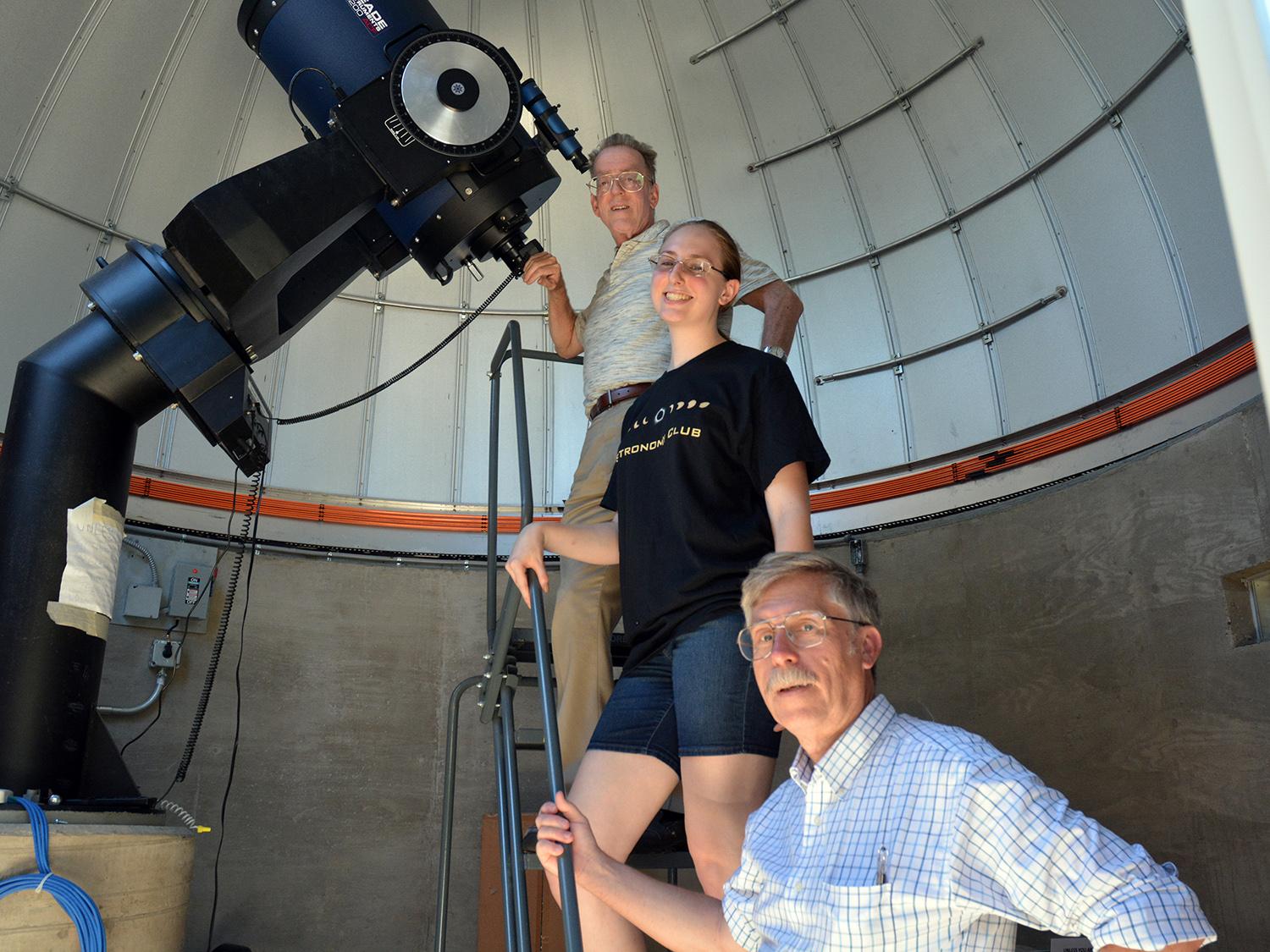Stairway to heavens -- Inviting people of all ages July 24 to 31 to SUNY Oswego's observatory at Rice Creek Field Station for the celestial event known as Mars in Opposition, physics faculty members Scott Roby (back left) and John Zielinski (right foreground) join recent graduate Kimberly Smith, a two-year past president of the student Astronomy Club, to demonstrate the facility's 16-inch telescope, one of several that will be in service during the Mars Viewing Party.
SUNY Oswego will host a free public Mars Viewing Party, planned nightly though weather-dependent, from 11 p.m. [UPDATED START TIME] to 2 a.m. July 24 to 31 at the college's observatory at Rice Creek Field Station
Astronomers of all ages can get a closer view of Jupiter, Saturn and, at the center of attention, Mars in Opposition. This celestial event occurs every two years, but this time with the "Red Planet" at its closest to Earth since 2003.
"Sixteen years ago, when I was at West Virginia University, we did this atop a big building, and 300 people showed up," said physics faculty member John Zielinski, chief organizer of the Mars Viewing Party.
Yet a chance to observe Mars and the other planets at Rice Creek this month should be a lot easier to come by: Besides the multiple nights of viewings, organizers from the physics department and the student Astronomy Club plan to offer multiple ways to view.
Scott Roby of physics, who for decades has conducted planetarium shows in the Shineman Center and its predecessor Piez Hall, said that other telescopes joining the observatory's 16-inch Meade LX200 ACF would include a 10-inch scope, a tabletop 3.5-inch AstroScan 2000, and perhaps others.
Casual observers could pique their interest in 20 to 30 minutes at Rice Creek, where the field station's restrooms will be open and a continuous presentation will run on a screen in the building, Zielinski said.
Mars in Opposition occurs when Mars, Earth and the sun are in a straight line. For visitors who want to know about the event in more depth, an organizer from the physics department will give a lecture at 10:30 p.m. [UPDATED TIME] before each night of viewing, he said.
The college's 16-inch telescope, pointed at the sky through an opening in the observatory's revolving dome, has a work platform to ascend for viewing. For teaching and research uses, it also has more advanced options, Roby said. There are three other "detectors" (used in observing labs): a high-tech camera that can generate images to a monitor, a CCD imager that serves as a scientific tool for measuring brightness and colors, and a spectrograph for measuring the chemical elements in a star or other celestial body.
Viewers can expect to see Jupiter and Saturn -- both higher in the July sky than Mars -- and, ideally, they should also see Mars in some detail, especially as it rises higher during the night. But weather conditions here and on Mars -- where a rare global dust storm currently rages, according to NASA -- can interfere.
Call first
Zielinski urged potential visitors to call his office phone at 315-312-2680 each night after 8 p.m. for a recorded message on conditions for that evening's viewing. If people don't call and arrive to find Rice Creek's gate closed near Thompson Road, the night's party is off due to poor viewing conditions.
Kimberly Smith, a recent graduate in geology with an astronomy minor, said she has been pleased to have a role in planning for the Mars Viewing Party and is excited to help play host.
"I'm very familiar with all the telescopes, and I'm the only student trained on the 16-inch telescope," said Smith, president of the Astronomy Club for the past two years. She expects to be answering questions and helping people view through the telescopes outside the observatory.
Astronomy Club viewings are always open to the public, she said, and there's one planned for a meteor shower at the end of October.
Zielinski said he believes the Mars Viewing Party will be a good experience for everyone from hobbyists to casual visitors.
"This will be in the national press," he said. "The public will hear about it and wonder how they can see it. They can right here!"




